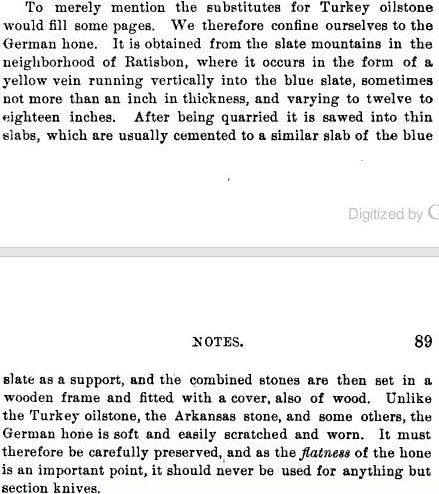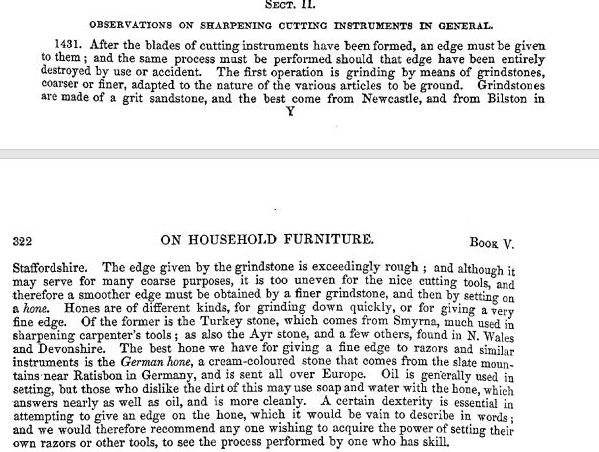Results 21 to 26 of 26
Thread: Hones Description article 1835
-
09-27-2012, 12:03 AM #21Senior Member


- Join Date
- Jul 2011
- Posts
- 2,110
Thanked: 459
Thanks for that explanation, Neil. Interesting that there was an accumulation of garnets somewhere other than where coticules seem to come from now, unless I'm misreading that.
We're on the same page about what a turkey stone is, at least from what I was talking about - the soft friable ones from greece, and not any of the number of stones called turkey stones later. I've seen several brownish arkansas stones sold here as "turkey" stones, don't know where that comes from but they definitely weren't what I was expecting when one person told me they'd mail me a "turkey stone" if I'd like to try it.
-
09-27-2012, 07:15 PM #22Senior Member

- Join Date
- Aug 2011
- Location
- Rhode Island
- Posts
- 161
Thanked: 32
Lots of interesting information in this thread! Those who found those hone descriptions informative might also enjoy this link I stumbed across recently. The hone descriptions start on page 15.
(1895) Essay on Barbers' Razors, Razor Hones, Razor Stropes & Razor Honing
-
09-27-2012, 07:23 PM #23
-
The Following User Says Thank You to Bushdoctor For This Useful Post:
MattW (09-27-2012)
-
10-16-2012, 11:57 PM #24Historically Inquisitive



- Join Date
- Aug 2011
- Location
- Upstate New York
- Posts
- 5,782
- Blog Entries
- 1
Thanked: 4249
-
The Following User Says Thank You to Martin103 For This Useful Post:
Margeja (10-17-2012)
-
08-27-2019, 04:41 PM #25

Just found this old post and only wanted to add my personal interpretation. From what i found till now it seems there is no „Ratisbon Razor Hone“. Its mentioned several times in older literature, also there was an old thin cut copper engraved in one if the older books.
What i found is for sure that sharpening stones and razor hones have been sold in Regensburg / Ratisbon from several suppliers. It often appears that hones are sold under other names then they normally should from their origin. This means often countries which imported the stones from another country did a marketing that way that the stones have been quarried from the country where those were sold in.
Its all a game of wrong labelling and wrong marketing....the history wrote down its own version of things which must not be 100% on the correct side.
I found Coticules being sold as German Hones, i found thuringians sold a British Hones or „british made“ i found Coticules names as German Hickory Hones.....
Holtzapfel mentions a German yellow Razor Hone which was known as „Old Rock“ so here we actually can see its total bullshit and nonsense. As a view from Holtzapfel himself it probably was reality at this time, or it was the only information available for him. But as we can see the reality is different!███▓▒░░.RAZORLOVESTONES.░░▒▓███
-
08-28-2019, 02:15 AM #26

It reminds of what Neil would have said....'Rubbish!'
-
The Following User Says Thank You to sharptonn For This Useful Post:
doorsch (08-28-2019)


 24Likes
24Likes LinkBack URL
LinkBack URL About LinkBacks
About LinkBacks






 Reply With Quote
Reply With Quote


